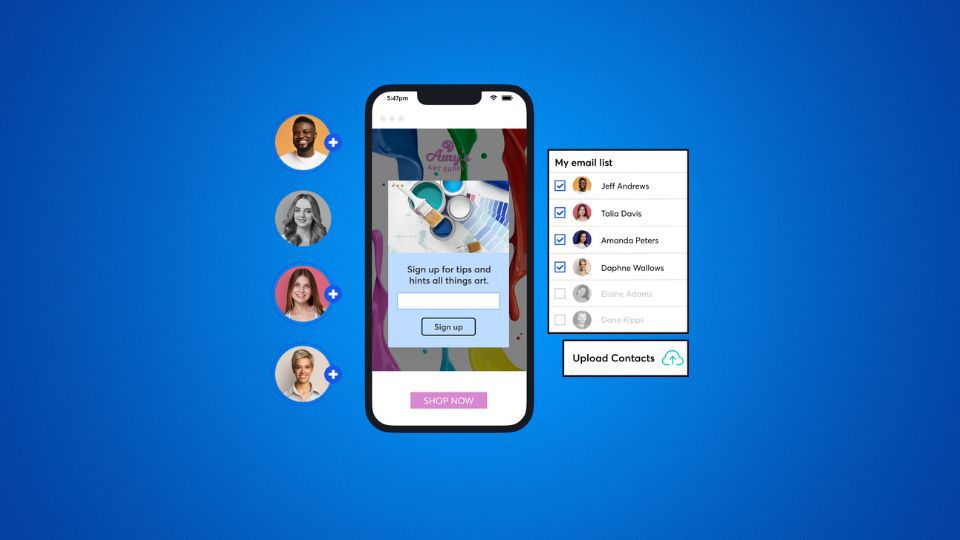Email marketing is a highly effective and budget-friendly way to generate leads and convert prospects for your business.
We’ve cultivated 10 best practices to help boost your results and, ultimately, the bottom line:
1. Never Purchase Contact Lists
The CAN-SPAM Act (U.S.) and General Data Protection Regulation (Europe) require that email recipients give consent before you reach out to them. That makes buying contact lists a big no-no! Sending emails from a purchased list is a surefire way to decrease open rates and spoil your brand’s reputation.
Instead, make it easy for people to opt-in. Email service providers like Constant Contact offer landing pages to collect contact data and keep you in compliance with the law. Provide opt-in links prominently on your website, email signature, and social media and QR codes at in-person events and point-of-sale locations. Don’t be afraid to sweeten the deal for subscribers by offering a discount, exclusive content, or incentives.
2. Don’t be Spammy
Emails are relationship-based. If you wouldn’t make 10 unanswered phone calls to a customer, you probably shouldn’t pepper them with 10 emails either. Bombarding someone’s inbox is a nuisance that often leads to unsubscribes and high spam rates. A good rule of thumb is one email per week for the best open rates. Most importantly, make sure that your emails are relevant and provide value to subscribers.
3. Write Compelling Subject Lines
We cannot overstate the importance of subject lines. Inboxes are crowded spaces, so an attention-grabbing subject line is crucial to getting your email opened. Keep your subject lines short and concise – between 30 and 50 characters (including spaces).
Good subject lines tell readers what to expect once they open the email and create a sense of urgency. Incentive-focused subject lines like “Free shipping when you spend $20 or more” or “Free iPod when you schedule a demo“, can drastically increase open rates.
Be sure to establish customer loyalty with industry insights and other non-sales content to nurture the connection and position your business as a thought leader and trusted source of information. Every email should not be a sales pitch.
4. Optimize the Preview Text
Your preview (or preheader) should supplement your subject line by adding details to encourage the reader to open. By default, preview text pulls in the first few words of the email and displays it next to or beneath the subject line in the inbox. This may or may not be the most compelling text to grab your audience’s attention. Instead, always write a custom preheader that teases what your email has to offer.
5. Include a Well-Placed Call to Action
The purpose of email marketing is not simply to get your emails opened but to compel the reader to act. Every email should have a strong Call to Action (e.g., visit our website, subscribe to our newsletter, signup for an event) that’s clearly visible. Placing it “above the fold” (in the area that’s visible without scrolling down) is generally recommended.
6. Stick to Three Typefaces
Clutter is the enemy of conversions. Too many words, fonts, and images can be distracting and difficult for the reader to follow. It takes away from the visual appeal and drowns out your call to action. Stick to one or two web-safe fonts with sizes between 12-point and 14-point.
7. Always Send a Test Email
You might think you’ve created the perfect email, but before you push that ‘send button’ be sure to test it first by sending a copy to yourself. Check to see how your email looks in the inbox, ensure that images are clear and undistorted, and do a final check to make sure that links are working. Test the email in HTML, plain-text, and on mobile devices.
While you’re at it, send a copy to a colleague for a “five-second test.” Can they quickly tell what your call-to-action is? If not, keep working.
8. Don’t Send From a ‘No-Reply’ Email Address
People open emails from senders they know and trust. Always send emails from your company name or a person with a first and last name. Never send emails from a no-reply address (e.g., [email protected]). No-reply emails are one-sided conversations that are less likely to be opened, provide zero customer service, and rob the receiver of their right to opt-out.
9. Personalize Your Content
Personalization engages subscribers and can be the difference between a successful email campaign and a failed one. Contacts are more likely to open emails addressed to them personally, so check to see if your email marketing platform allows you to personalize the greeting or subject line with the recipient’s name. Avoid using generic greetings such as “Dear Subscriber.”
As you gather data on subscribers’ interests, preferences, and behaviors, you can further customize emails to meet their needs, such as reminding users about products in their cart or suggesting events based on past registrations.
10. Clean Your Mailing Lists Regularly
Finally, it’s important to regularly look through your email lists and clean out subscribers who rarely or never open your email campaigns. Keeping inactive contacts on your mailing rate drags down open rates, skews your analytics, and annoys subscribers with emails they’re not interested in. Consider emailing inactive contacts less frequently or trying to recapture their attention with a special “we miss you” offer.
With a return on investment of $42 for every $1 spent, email marketing is a proven, cost-effective marketing tool. We’ve cultivated these best practices over 22 years in business and hope you’ll start using them today to boost your results and your bottom line.

